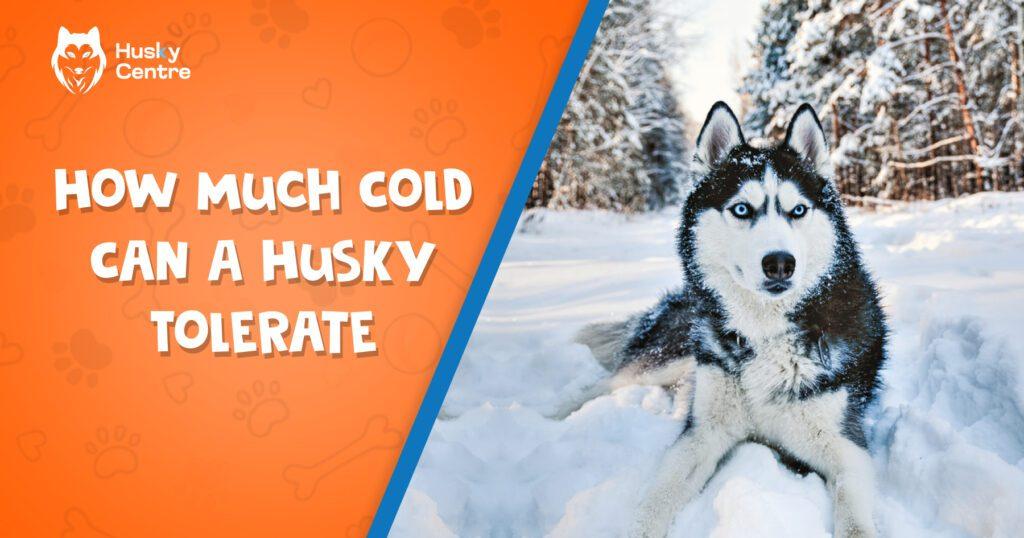A Husky can tolerate extremely cold temperatures, down to minus 60 degrees Fahrenheit. Their thick double coat provides ample insulation against frigid conditions.
Huskies are a robust breed known for their endurance in wintry landscapes. Originating from Siberia, their dense fur and unique genetic adaptations make them one of the most cold-resistant dog breeds. Pet owners often marvel at a Husky’s love for snow and capacity to thrive in what would be harsh environments for other dogs.
Their ability to deal with the cold is legendary, often leading them to prefer the crispness of winter over the warmth of summer. It’s not just their coat that enables them to handle the cold; it’s also their efficient circulation and behavioral adaptations, such as curling into a tight ball to sleep, using their bushy tail to cover their noses and face. Understanding these characteristics is essential for any Husky owner or enthusiast, ensuring these dogs are kept in environments where they can remain happy and healthy.
The Husky Heritage And Cold Tolerance
Imagine going for a long walk in the snow without a jacket. Sounds too cold? Not for the Husky! These dogs have a unique ability to deal with freezing temperatures. Let us dive into the remarkable traits that allow Huskies to thrive in extreme cold environments.
Siberian Roots And Adaptations
Huskies hail from Siberia, where icy winds and heavy snow are the norms. They were bred by the Chukchi people to pull sleds over vast snowy expanses. Their thick fur and strong bodies were vital for survival. Here are some adaptations that help them cope with the cold:
- Double-layered coat: Insulates against the chill
- Powerful legs: Help in trudging through snow
- Dense fur around paws: Acts as snow boots
Their physical build and coat density are perfectly suited for a snow-covered landscape.
Physiological Cold Defense Mechanisms
Huskies also have internal features that protect them from cold. These are not just skin-deep:
| Feature | Function |
|---|---|
| High metabolism | Generates body heat |
| Vascular system | Manages blood flow to skin |
Their metabolism acts like a furnace, warming them from the inside out. Their blood flow system helps to keep their skin temperature just right, preventing frostbite.
With heritage deeply rooted in the Siberian winter, Huskies tolerate the cold not only with grace but with relish. These dogs can comfortably embrace temperatures as low as -60°F (-51°C), which is well beyond what most pets and even humans can bear!
Breaking Down The Siberian Husky’s Winter Wardrobe
The Siberian Husky thrives in cold environments. This breed boasts a unique coat designed for frosty weather. Let’s dive into what makes these pups winter-ready.
Double-layered Coat Explained
Siberian Huskies come equipped with a double-layered coat. This feature is nature’s design for insulation. Here’s how it works:
- Outer Layer: Long guard hairs repel water and block wind.
- Undercoat: Dense and fluffy, it traps warm air.
These layers allow Huskies to tolerate temperatures far below freezing.
Paw Protection And Insulation
Paws are vital for Husky’s mobility in the snow. Special features protect their paws:
- Thick Fur: Between toes, fur keeps snow out and warmth in.
- Leathery Pads: They act as barriers against freezing ground.
Huskies’ paws are the pinnacle of natural snowshoes.
Analyzing Husky Behavior In Cold Climates
Understanding how huskies thrive in cold weather is intriguing. These dogs hail from icy regions. Their behavior in frigid climates shows remarkable adaptations. Let’s delve into their world to discover how they cope with the cold.
Snow Dens: More Than Just Play
It might seem huskies are playing in the snow. They are building survival homes. Snow dens serve as a warm refuge. Watch huskies dig and rest in these snow-crafted nests. They use body heat to keep these dens cozy.
- Insulation: Snow traps air, which insulates huskies from cold.
- Shelter: Dens protect from harsh winds.
- Rest: Dens offer a spot to recover energy.
Energy Conservation Strategies
Huskies are smart about saving energy. In cold weather, they slow down to conserve warmth. Notice their behavior changes:
| Behavior | Purpose |
|---|---|
| Curled Position | Retains body heat |
| Thick Fur | Blocks cold air |
| Calmer Demeanor | Uses less energy |
Understand these behaviors to see how huskies excel in the cold. They curl up to trap warmth. Their fur acts like a blanket. Less movement means saving energy for when it’s needed.
The Limiting Factors For Huskies In The Cold
Siberian Huskies thrive in frosty climates, a trait inherited from their ancestors. These majestic canines were bred to pull sleds across icy tundras. Despite their resilience, they have limits in the face of extreme cold. Understanding these limits is key to ensuring the safety and comfort of a Husky in wintry environments.
Temperature Thresholds Revealed
Huskies boast a dense double coat to insulate against the chill. Optimal temperatures for Huskies typically range from -20°C to 10°C. Yet, not all Huskies are alike. Individual tolerance can vary based on health, age, and acclimatization. At temperatures below -20°C, vigilant monitoring is crucial to safeguard a Husky’s well-being.
Signs Of Cold-related Stress
Dogs communicate discomfort in various ways. In biting cold, look for these signs in your Husky:
- Whining or barking: May indicate unease or a plea for shelter.
- Shivering: A clear sign the dog is too cold.
- Anxious behavior: Pacing or looking for places to burrow in.
- Limping: Can be a sign of frostbite or ice buildup in their paws.
If you notice any of these behaviors, it’s time to warm up. A Husky’s love for snow doesn’t make them immune to its risks.
Caring For Your Husky During Winter
Caring for your Husky during winter requires special attention to ensure they stay warm and healthy. Although Huskies are well-adapted to cold climates, it is essential to monitor their exposure and diet during the colder months. Proper care will keep your Husky happy and comfortable, even when the temperature drops significantly.
Balancing Outdoor Exposure
Huskies thrive in cold weather but balancing their outdoor time is key. Keep an eye on the temperature and wind chill factor. Temperatures below -20°F (-29°C) can be harmful, even to a Husky’s thick coat. Shorten the walks and playtimes to prevent frostbite and hypothermia. Provide shelter from harsh winds and ample bedding for insulation.
- Limited time outdoors in extreme cold
- Supervise for signs of discomfort
- Provide a warm shelter
Diet And Nutrition For Optimal Warmth
Diet plays a crucial role in keeping your Husky warm. Higher protein and fat during winter support their increased energy needs. Adding fish oils can improve coat health, offering better insulation. Ensure constant access to fresh, non-frozen water to prevent dehydration.
| Component | Benefit |
|---|---|
| Increased Protein & Fat | Boosts energy and insulation |
| Fish Oils | Improves coat health |
| Fresh Water | Prevents dehydration |
Regular check-ups with a vet can ensure your Husky’s diet is on track. Adjust food portions according to your Husky’s activity level. Avoid overfeeding and monitor your Husky’s weight to maintain a healthy balance during winter.
- Higher calorific intake as per activity
- Regular health check-ups
- Balanced portion sizes
Monitoring And Responding To Extreme Conditions
Monitoring and responding to extreme conditions is vital for any dog, especially huskies. These strong dogs have thick fur and a history of thriving in cold climates. Yet, knowing their limits remains crucial for their health and safety.
Emergency Precautions
Acting quickly is key in cold extremes. Owners should always:
- Provide Shelter: A warm space to protect from wind and snow.
- Check Paws: Ice can harm their paws. Consider dog-safe salt or booties.
- Stay Dry: Wet fur can lead to cold stress. Towel off any moisture.
- Limit Time Outdoors: Even huskies need breaks from severe cold.
Understanding Hypothermia In Huskies
Hypothermia is a danger in low temperatures. Recognize the signs:
| Sign | What to Do |
|---|---|
| Shivering: | Warm the dog slowly and gently. |
| Sluggishness: | Contact a vet immediately. |
| Whining: | Offer a warm blanket and reassurance. |
| Anxiety: | Remain calm to help them relax. |
Keep an emergency kit ready. Include blankets, warm water bottles, and a thermometer.
Frequently Asked Questions On How Much Cold Can A Husky Tolerate
What Temperature Can Huskies Withstand?
Huskies are bred for cold climates and can typically withstand temperatures as low as -60°F (-51°C) with proper shelter and care.
Do Huskies Need Winter Clothing?
Most Huskies do not need winter clothing due to their double coat, which provides ample insulation against the cold.
How Do Huskies Stay Warm?
Huskies stay warm with their thick double coat, consisting of a dense undercoat and a longer topcoat that trap heat effectively.
Can Huskies Live In Hot Climates?
Huskies can live in hot climates if provided with adequate shade, water, and air conditioning, but they are generally more comfortable in cooler environments.
How To Protect My Husky In Winter?
Ensure your Husky has access to a dry, insulated shelter and monitor their time outdoors to prevent frostbite and overexposure in extreme cold.
Conclusion
Siberian Huskies boast a remarkable resilience to cold, a legacy of their origin. Their dense fur and enduring spirit allow them to thrive in chill climates, often well below freezing. Indeed, Huskies are the epitome of winter hardiness but remember, they also cherish care and shelter.
Ensure your furry companion’s well-being with proper precautions during extreme cold.


Meet Jarred, the heart and soul behind HukyCentre. With a deep affection for furry friends, he pours his passion into every word he writes. His genuine love for dogs shines through in his engaging and informative content. As a dedicated dog enthusiast, Jarred’s goal is to share valuable insights and tips that resonate with fellow dog lovers. Join Jarred on the journey as he celebrates the joy and companionship that dogs bring into our lives.



